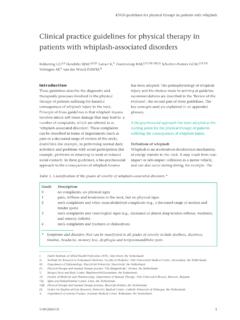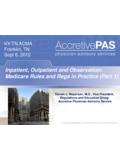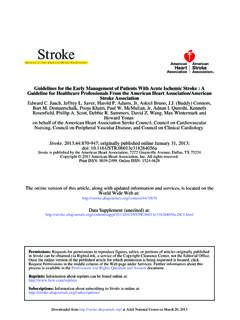Transcription of Rehabilitation Guidelines for Unilateral Total Knee ...
1 Updated University of Delaware Physical Therapy Clinic Newark, DE 19716 (302) 831-8893 rehab Practice Guidelines for: Unilateral Total knee arthroplasty (TKA) Primary Surgery: Tricompartmental, TKA-any approach Assumptions: 3-4 weeks post-tricompartmental TKA, up to 1 week of inpatient Rehabilitation after acute care stay, up to 2 weeks (4-6 visits) of home physical therapy1-2, 5-6 Assumptions for outpatient physical therapy: Active range of motion (AROM) approaching 90 of knee flexion, minimal pain/swelling, independence in mobility in and out of home2 Expected number of visits: 16-18 visits Time Treatment2 Milestones Early 3-6 Weeks Post-Operatively Visits 1-6 ROM2 Exercise bike for 5-10 minutes, forward and backward pedaling with no resistance until able to perform full revolution Supine, active-assistive wall slides or prone quadriceps stretch with strap for knee flexion Passive knee extension stretch with manual pressure or weights (seated bag hang, or prone bag hang) Patellar mobilizations for 3 sets of 10 reps of inferior, superior glides, medial, and lateral glides as necessary3 NMES 1-2, 5-6: See end note for Guidelines Volitional Strength2 Strengthen at 70% of 8 RM with 3 sets of 8 reps for all strengthening exercises Initial exercise examples.
2 SLR, hip abduction sidelying, SAQ, step-ups at 5-15 cm, 45 wall slides or sit to stand, standing TKE with Theraband for resistance from 45-0 Increase step height if good concentric/eccentric control AROM/PROM 0 to > 105 of flexion2 Minimal to no pain and swelling2 Voluntary quadriceps muscle control or 0 knee extension lag2 Heel strike/push off achieved with least restrictive device. Begin focusing on TKE in stance phase of gait. Obtain baseline isometric quadriceps index, and activation with a superimposed electrical stimulation burst within the first week of outpatient PT. Mid 5-8 Weeks Post-Operatively Visits 7-12 ROM2 Exercise bike for 5-10 minutes, add resistance if able to perform full revolution, lower seat height to produce stretch with each revolution Continue ROM activities as described in early treatment section with increased duration until milestones are achieved NMES1-2, 5-6: See end note for Guidelines Volitional Strength2 Continue to progress exercises if able to perform 3 sets of 10 reps of the exercise correctly with maximum fatigue Progression: Progress from 8RM to 10 RM Reassess 10RM weekly and exercise at 65% - 70% 10RM Consistent with carryover of AROM 0 to >115 Collaborate with surgeon if by 4-6 weeks post-op carryover of AROM in flexion is less than 10 -15 from initial outpatient PT evaluation measurement.
3 Steady increase in MVIC3 Updated Exercise examples: Leg press and leg extension at 65-70% 1 RM, 4-way hip exercises with resistance, climbing a flight of stairs, walking with change in speed and incline. Late 7-10 Weeks Post-Operatively Visits 13-18 ROM2 Continue as previously described until milestones are achieved NMES 1-2, 5-6: See end note for Guidelines Volitional Strength2 Continue to progress exercises if able to perform 3 sets of 10 reps of the exercise correctly with maximum fatigue AROM 0-12077 Walk foot over foot up and downstairs without assistive device Unlimited walking distance with normalized gait and least restrictive device Retest isometric quadriceps index and activation. Quadriceps at 70% strength of uninvolved side ROM: range of motion; AROM: active range of motion; PROM: passive range of motion; > greater than; reps: repetitions; SLR: straight leg raise; RM: repetition maximum; TKE: terminal knee extension; SAQ: short-arc quadriceps; MVIC: maximum volitional isometric contraction.
4 PT: physical therapy Pain and swelling Ice, compression, and elevation daily after exercises1-2, 5-6 Incision mobility Soft tissue mobilizations to entire length of incision with greater emphasis on distal 1/3 of incision1-2,5-6 until incision moves freely over subcutaneous tissue3 Vital Signs Monitored during each session2 NMES Protocol Guidelines1,2,5,6 Electrodes placed over proximal lateral quadriceps and distal medial quadriceps Stimulation Parameters: 250-400 usec, 50-75 Hz, 2 second ramp, 12 second on, 80 second off, intensity to maximum tolerable or at least 30% of the maximum volitional isometric contraction (MVIC), 10 contractions per session 3 sessions per week until quadriceps strength MVIC is 70% of uninvolved. Performed isometrically at 0- 60 degrees of knee flexion dependent on tolerance and therapeutic goal (ie. near max extension for quad lag, etc.) References 1. Lewek M, Stevens J, Snyder-Mackler L. The use of electrical stimulation to increase quadriceps femoris muscle force in an elderly patient following a Total knee athroplasty.
5 Phys Ther. 2001;81:1565-1571. 2. Meier, W. et al. Total knee arthroplasty : Muscle Impairments, Functional Limitations, and Recommended Rehabilitation Approaches. J Orthop Sports Phys Ther. 2008;38(5):246-256 3. Mizner, R., Petterson,S., Synder-Mackler, L. Quadriceps Strength and Time Course of Functional Recovery after Total knee arthroplasty . J Orthop Sports Phys Ther. 2005;35(7):424-436. 4. Petterson S, Snyder-Mackler L. The use of neuromuscular electrical stimulation to improve activation deficits in a patient with chronic quadriceps strength impairments following Total knee arthroplasty . J Orthop Sports Phys ;36:678-684. 5. Snyder-Mackler L, Delitto A, Stralka SW, Bailey SL. Use of electrical stimulation to enhance recovery of quadriceps femoris muscle force production in patients following anterior cruciate ligament reconstruction. Phy Ther. 1994;74:901-907. 6. Stevens JE, Mizner RL, Snyder-Mackler L. Neuromuscular electrical stimulation for quadriceps muscle strengthening after bilateral Total knee arthroplasty : a case series.
6 J Orthop Sports Phys Ther. 2004;34:21-29. 7. Kurosaka M, Yoshiya S Mizuno K, Yamamoto T. Maximizing flexion after Total knee arthroplasty : the need and the pitfalls. J arthroplasty . 2002; 17(4 suppl): 59-62.












